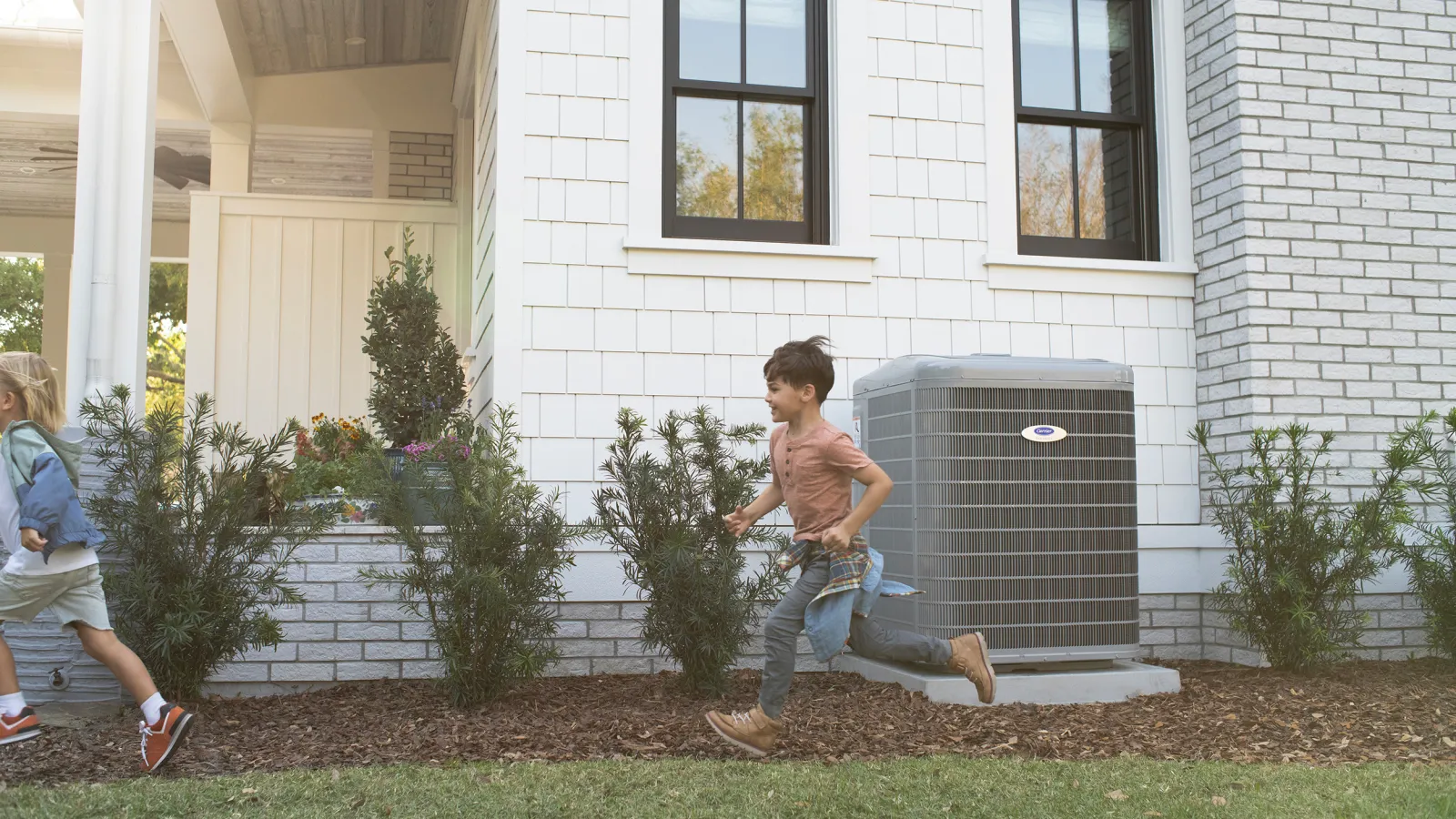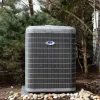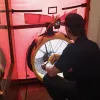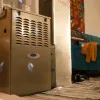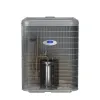Heat pumps really are the talk of the town these days.
Depending on what you’ve read, you may have heard that they cool your home in summer and heat your home in winter. You may also have heard that they do this in any climate zone and that they’re the best choice if you’re trying to go all electric or wean yourself off of fossil fuels.
You may even have heard that heat pumps cost less to operate than gas furnaces.
So. Is the hype for real? Are heat pumps better than furnaces?
Here at PV, we don’t benefit when you choose a heat pump over a furnace or vice versa. We’re a heating and air company. If you want a heat pump, we’ll perform a Manual J load calculation and install one. Ditto if you want a new natural gas furnace.
Basically, we don’t have a vested interest in telling you whether a heat pump or furnace is superior. If someone hires us to install and/or service one or the other, that person is a customer either way.
What we can tell you, however, is our opinion on the heat pump vs. furnace question as professionals who literally handle these systems every day. The truth is, furnaces and heat pumps are a lot alike. They’re also different in several key respects.
Let’s take a look at how each type of equipment works and consider all benefits and drawbacks as we attempt to answer this frequently asked question.
How a Heat Pump Works
A heat pump removes heat from one area and releases it somewhere else.
That’s the short explanation for how it works, but you’re probably looking for a little more specificity. A heat pump contains a liquid called refrigerant. This refrigerant cycles continuously through copper tubes. These tubes run between two large machines, one that lives outside your home and one that lives inside (usually in an attic, crawlspace, or basement). The outdoor unit contains a compressor, a coil through which the refrigerant cycles, and a condenser fan. The indoor unit also contains a coil as well as a big fan, known as the blower.
During the summer, a heat pump system removes heat from the air inside your home, transfers it to the refrigerant, and then expels that heat from the refrigerant outdoors. If you’re thinking, “Hey, that’s how an air conditioner works,” you’re correct! Air conditioners remove heat from the indoor air and move to the outdoors, just like a heat pump. Your refrigerator works in a similar fashion. It moves heat from inside the fridge to the environment outside the fridge.
“Wait a second. Are you saying I already have a heat pump in my house?”
Sort of. Air conditioners move heat in one direction: from inside to outside. Heat pump HVAC systems move heat in both directions. They can pump heat into your house in the winter. When anybody claims that heat pumps are better than furnaces or vice versa, they’re comparing furnaces to systems that use refrigerant to move heat from outdoors to indoors.
When someone heats their home with a heat pump, the system basically works like an air conditioner in reverse. Instead of moving heat from your home to the outdoors, the heat pump moves heat from the outdoors into your home.
Limitations of Traditional Heat Pumps
The problem with “classic” heat pumps is that they’re really only efficient down to a certain outdoor temperature. While there’s still plenty of heat to extract from the air until temperatures get down in the 40s, the old type of heat pump would struggle when it got colder than that.
Basically, the heat pump wouldn’t be able to extract much heat from the air when temperatures were in the 30s or below. These kinds of heat pumps struggled to satisfy thermostat settings… unless they had some help.
That “help” usually came in the form of heat strips, also known as “auxiliary heat.
Heat strips are big heating coils that use lots of electricity to produce heat. When they’re on, it’s like running air through a giant toaster. They’ll heat your home, but they’ll use a lot of energy in the process!
People with the old style of heat pump tend to have high heating bills, which is why heat pumps often get a bad rap.
Newer Heat Pumps
Many new heat pumps don’t have this problem. These units rely on variable speed technology to provide efficient performance down to really low outdoor temperatures. So much so that even people in really cold climate zones are installing them and running them all through the winter without using heat strips.
Of course, it’s vital that your home be properly insulated and air sealed in order to enjoy this kind of performance from your heat pump. But if it is – and if the heat pump is sized properly – you shouldn’t have anything to worry about!
Keep in mind that the older, “on/off” style heat pumps with heat strips still do a good job heating your home. They just aren’t as energy efficient as new, variable speed units and don’t provide the same consistency of comfort.
Here in the Southeast, it doesn’t get nearly as cold as many of the places where people are successfully using heat pumps throughout the winter. The latest heat pumps are very efficient. If you think you want one, heating your home in winter isn’t something you need to worry about.
How a furnace works
Unlike a heat pump, a furnace doesn’t move heat between the indoors and the outdoors. A furnace creates its own heat by burning fuel.
When a furnace turns on, it burns natural gas or propane to generate heat. Inside a furnace, there are actual burning flames. Not so with a heat pump.
The heat from the furnaces’s burners enters a device called a heat exchanger. A big fan called the blower then moves air over the heat exchanger. This makes the air hot. The blower then carries the hot air through your ducts and into your living space. It keeps running until your thermostat tells it that it’s reached the target indoor temperature.
That’s really it! Virtually all modern residential furnaces work this way.
Sure there are variations in process and efficiency – high-efficiency furnaces work differently from standard models, for example – but the fundamentals are the same.
Unlike older heat pumps, furnaces remain efficient after the outdoor temperature drops. Since the furnace isn’t trying to squeeze heat out of cold, outdoor air, it doesn’t use as much energy as the older, less efficient heat pumps. The furnace can keep burning gas no matter what the temperature is outside.
Ways furnaces and heat pumps are the same
Fact: During the winter, either a furnace or a heat pump will make your house warm.
Each type of system is capable of heating your home. If it’s 18 degrees outside one night in January and you have a heat pump, you can set your thermostat to 68 and your home will stay at 68 degrees all night long. Same for a furnace, assuming it’s the right size for your home.
The only caveat is that a very poorly insulated, non-air sealed home with a lot of duct leakage might have problems if you’re using a heat pump. We got calls from frustrated heat pump owners last winter when overnight lows were around 5 degrees. Their systems weren’t heating their homes past 60 and they thought something was wrong.
Nothing was wrong. The problem was that their homes were super drafty and poorly insulated from the cold! Also, the heat pumps they were using were only designed to heat down to the point where the outdoor temperature was 24 degrees.
Would a furnace have kept these homes warmer? Maybe so. A gas furnace would have continued to burn fuel and produce heat until the temperature inside the home increased. Since many furnaces in our region are oversized for the homes they’re tasked with heating, a furnace would have had the capacity to heat the home to a high temperature on these very cold days.
The downside of an oversized furnace, of course, is the short cycling, wasted energy, and inconsistent temperatures among different rooms. For every homeowner who wasn’t satisfied with their heat pump last winter, there are just as many – or more – homeowners who aren’t satisfied with their furnaces!
These issues aside, heat pumps and furnaces are equally able to heat your home to a comfortable temperature under normal conditions.
Are operating costs the same?
It’s hard to say. At the time of writing, natural gas prices are pretty low. It’s hard to make the argument that heat pumps are a more economical choice. Depending on your cost per therm (natural gas) or kilowatt hour (electricity/heat pump), one may be a little more cost effective than the other… for now.
According to some authorities, a heat pump is the more future-proof option. If you believe that most of the innovations in energy production are happening with electricity, then you might conclude that the cost to operate a heat pump will only get cheaper over time.
We don’t take a position on that one way or the other, but we do have customers who switched to heat pumps for this reason.
Ways furnaces and heat pumps are different
There are differences! Here are a few of them:
- The way they heat your home: We’ve already discussed this. Heat pumps transfer heat from one place to another; furnaces burn fuel on site.
- How the heat feels: Furnaces usually blow hotter air out of their supply registers than heat pumps. Ultimately, a heat pump will still increase your temperature to whatever you’ve set on the thermostat, but the air might not feel as hot when it’s coming out of the vents.
- Combustion safety risk: No fuel combustion happens in a heat pump. There’s nothing to ignite or burn. Furnaces, on the other hand, rely on combustion to heat your home. They ignite and burn gas. The exhaust fumes are toxic, but the furnace vents these to the outdoors as long as it’s working properly. Still, you will need to have your furnace tested for safe combustion on a regular basis. If the heat exchanger develops a crack, dangerous combustion gasses can enter your home.
- Fuel source: Heat pumps are electric. Furnaces burn natural gas or propane. Some of our customers want to reduce their dependence on fossil fuels, and switching to a heat pump is one way to do that. You can power a heat pump with a solar array, for example. In Georgia, most electricity currently comes from a combination of fossil fuels, nuclear, and other power sources. Still, a heat pump would be the way to go if you anticipate switching to solar one day.
Is one better than the other?
No! Heat pumps and furnaces are both good options for heating. It’s really all about personal preference.
Some people genuinely prefer the way furnaces heat. They like the “hot heat” they feel coming from the supply registers. It’s what they’re used to, and it’s what they want. That’s fine! Also, if you already have gas lines running to your home, it usually makes sense to keep using them.
Other people are trying to get away from fossil fuels. Maybe they’re trying to go all electric or maybe they just don’t want fuel combustion to happen in or around their home. For these folks, a heat pump is a better choice.
Get the benefits of both with a dual fuel system
Did you know you can heat your home with a heat pump and a furnace?
With a dual fuel system, you use a heat pump to heat your home when temperatures are in that “cold-but-not-super-cold” range. Think high 50s to low 40s. Then, when the heat pump would normally switch to heat strips, your furnace turns on instead.
Many people consider dual fuel to be the best of both worlds, especially if they’re still using the old style of heat pump that isn’t very efficient during really cold weather. Furnaces also cost less to operate than the heat strips inside your heat pump, so you enjoy cost savings as well.
Conclusion: Heat pumps aren’t better than furnaces. They’re just different.
There are advantages and disadvantages for each type of system. Thankfully, both are capable of heating your home.
If you’re trying to choose between a heat pump, furnace, or dual fuel setup for your Atlanta-area home, we can help! Get in touch today and tell us what’s going on with your heating system!
